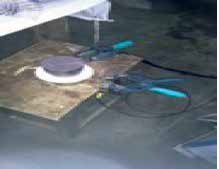Studies on Designing of Durable Superhydrophobic Surfaces for Outdoor Insulators
Introduction
The main objective of this project was to design durable superhydrophobic surface for outdoor insulators. Apart from making its surface superhydrophobic the distribution of electric stress as well as the thermal stress over the insulator surface has to be uniform in order to increase the life of the same i.e. to make it durable. In this project the first target was to achieve reduction in electrical stress over silicone rubber by mixing different proportion of weights of metal oxide nanofillers with silicone rubber.
 |
 |
FESEM Analysis of one of the samples |
Capacitance and Tan delta testing of one of the samples |
Achievements
The samples have been fabricated by mixing titanium oxide in different proportion by weight with the industry graded silicone rubber (RBB 2888-60). These compoundings were verified by the Field Emission Scanning Electron Microscopy (FESEM) analysis and they have been found to be uniform.
Electrical properties of the prepared samples were obtained. These include capacitance, dielectric loss angle
for different frequencies at different voltage levels. From the obtained values, dielectric constants, electrical
conductivities and dielectric losses have been calculated. The breakdown voltages of the fabricated materials
have also been measured.
Thermogravimetric analysis (TGA) and differential thermal analysis (DTA) have been done to obtain the thermal properties of the samples. From DTA and TGA analysis the phase transition of the fabricated materials have been analysed. Accordingly specific heats and thermal conductivities of the samples have been obtained.
Simulation of electric stress over a post insulator surface stressed between the live electrode and the ground electrode and the distribution of equipotential lines on and around it has been studied. The results obtained were compared by considering the insulator to be made of different samples of the compounded that were fabricated with respect to the results obtained for the sample made only with silicone rubber without mixing any nanofillers.
Promising results have been obtained with nanofiller compounded silicone rubber samples as compared to those without nanofiller compounding. Considerable reduction in electric stress has occurred over the insulator surface using nanocompounded silicone rubber.
For further information please contact
Supreme Knowledge Foundapaltion Group of Institutions
1, Khan Road, Mankundu Hooghly,
West Bengal 712139
Email : jit_lahiri@yahoo.com







